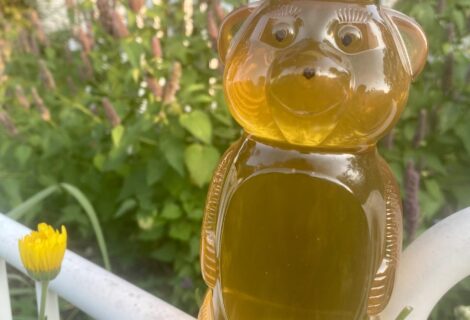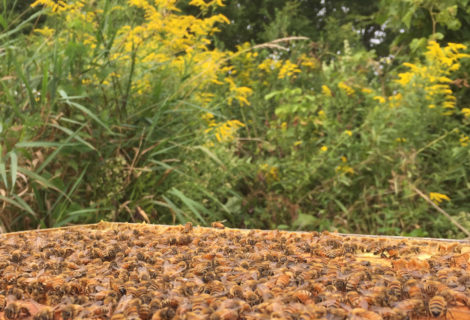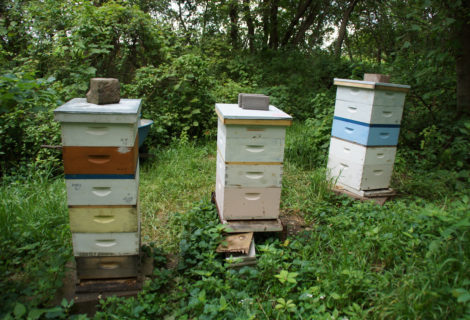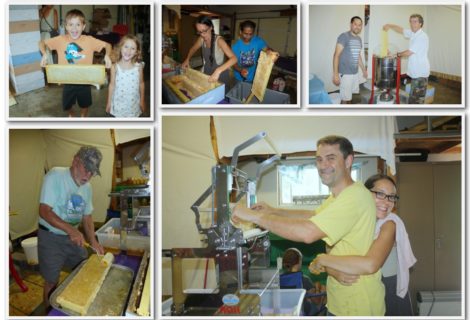Queens going and coming
With all the things that happen in and around the hives, I could be posting much more often. I think I just need to learn to do shorter posts sometimes of ‘snapshots’ of what we see happening. I checked on many of the colonies Sunday. They are making honey, and some of them are going queenless or trying to re-queen. I mentioned in an earlier post that we had a dozen queen-right colonies, but likely wouldn’t stay that way. That’s true.
I think one of the splits swarmed in June and a new queen took up residence. Here’s the type of queen I put in the box – taken on June 19 from a different colony – a nice marked Carniolan. Notice how the worker bees that are around, no matter how their bodies are orientated, they tend to turn their heads toward the queen.
In the hive that I was expecting to find the above type of queen, instead, we snapped the following photo (also on June 19) of a new queen that had just mated and started to lay eggs:
Amazing! Instead of the dark Carniolan, she looks like that of the bronze Italian race. So, the former queen must have mated with non-Carniolan drones. And she probably took at least a third of the colony and swarmed to a new home. We never saw them leave. I did take one of the queen cells out of the hive a week or two before, but they must have had others. Those other cells start to “hatch” after the swarm leaves. The virgin queens “pipe” to each other while still in their capped cells. They are possibly communicating “I’m going to get you first!”. Because the first one out of her cell finds the other cells and stings those rival virgin queens before they emerge if possible. Then the survivor leaves the hive on her maiden/mating flight. If fortunate to not be consumed by bird or some other creature, she’ll come back to the colony and start laying.
On Sunday, I found 3 more colonies that were already queenless or going queenless. All colonies that started from packages this year, which was a little surprising to me. I had good luck with packages last year. This year it was about 50/50. Half are doing well. The other half were in this re-queening process, which creates a large break in the brood cycle, and the hive shuts down extra honey production, at least for a while. So that is one reason, we are not adding as many supers this year. Underneath the queen excluder on one of the colonies, I found several queen cells I inadvertently broke in the process of taking off the excluder. Here is the underside of the queen excluder, looking up:
It looks like a queen cup, all prepared with royal jelly for a new larva, but in fact, the bulging larva had been in it for some time. The other half of the queen cell was affixed to the top-bars of the frames in the brood box below.
The bees are like “Ack! All that work wasted.” And I was saying the same thing. I’d rather not spend $30 for a new queen if they can make their own. Fortunately, there were two other intact queen cells affixed to the frames on the bottom of the box, so hopefully those remained viable. If so, one should be hatching about now.
In the colony right next to this, I found only the last remnants of any brood nest, which means there has not been a queen around for almost 3 weeks. That is kind of a sad situation, because it’s likely that colony would reject a new queen that I introduced at this point. If I hadn’t ripped up several of the queen cells in the other colony, a couple of those could have been provided to this colony, to see if they would accept a new queen emerging from a regular queen cell.
On the bright side, they were storing nectar and capping honey in the brood boxes where the brood nest used to be. They are preparing for winter.
So, although they are not making this honey for us, it’s still a beautiful sight. The nectar was just sparkling, and you can see from the photo above, they are capping the h0ney from the top and corners –> down the frame. Can you spot the two drones? They are loving the free food provided for them here. I will likely need to combine this hive with another weak one to try to overwinter them as one colony.
Finally, here’s ‘grandpa bee man’ with his colony going strong. Their queen must bee doing well. We just added the 4th super on Sunday, and for most of the other 3, they have drawn fresh wax from foundation. Really nice!












Recent Comments